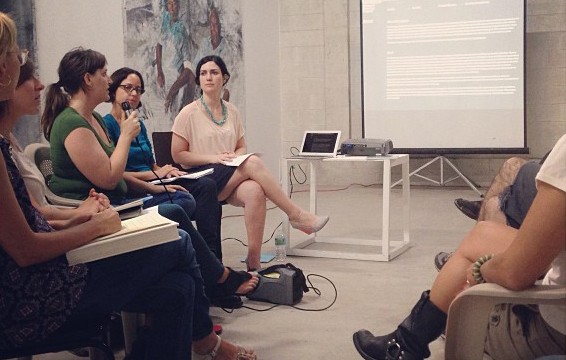
“What is Line” panel discussion at BFI, with The Drawing Project
the following are notes that prompted the panel discussion
Tuesday, April 30, 7pm
Panel Discussion: What is line?
Panel discussion will revolve around the elusive definition of drawing and line with input from artists and arts professionals working with the medium. Panelists: Emmy Mathis, Felice Grodin, Amanda Sanfilippo, and Jenny Brillhart, moderated by Sarah Michelle Rupert
Bas Fisher Invitational, 100 NE 11 Street, Downtown Miami
What is line; how does it travel through space, and how does this interaction define place?
In Foucault‘s article “Of Other Spaces”, he states:
the present epoch perhaps will be above all an epoch of space.
What is the first thing you think of when you hear this comment?
Lets continue with the free association (lol).
What do you picture when you hear the word space?
Do any other artists or projects come to mind?
What do you think aboutt when you hear the word border?
Any projects?
The poetics of space or the politics of space?
Foucault said that we are living in “an epoch of space,” what do you think that means?
Line
How do you define line?
What is a line’s relationship to space?
Is space simply the environment where a line exists, or is the relationship more complex?
Do they exist in the same dimension?
What is your work’s relationship to line? What about drawing?
Place
What about place? what do you think of when you hear the word place?
What is your practices relationship to place?
What is the difference between place and space?
What is your practices relationship to that difference?
What is lines relationship to that difference?
Do you think your responses have been about internal space or external space?
What other types of space can you think of?
What types of place?
In “One Place after Another: Notes on Site Specificity” October, Vol. 80. (Spring, 1997), pp. 85-110., Miwon Kwon completely leaves out the viewer and the body:
furthering previous attempts to take art out of the museum/gallery space-system, contemporary site-oriented works occupy hotels, city streets, housing projects, prisons, schools, hospitals, churches zoos, supermarkets, etc. and infiltrate media spaces such as radio, newspapers, television, and the internet. in addition to this spatial expansion, site oriented art is also informed by a broader range of disciplines, (ie anthropology sociology, literary criticism, psychology, natural and cultural histories, architecture and urbanism, computer science, political theory) and sharply attuned to popular discourses (ie fashion, music, advertising, film, and television) but more than these dual expansions of art into culture, which obviously diversity the site, the distinguishing characteristic of today’s site-oriented art is the way in which both the art work’s relationship to the actuality of a location (as site) and the social conditions of the institutional frame (AS SITE) are subordinated to a discursively determined site that is delineated as a field of knowledge, intellectual exchange, or cultural debate. Furthermore, unlike previous models, this site is not defined as a precondition. Rather, it is generated by the work (often as “content”) and then verified by its convergence with an existing discursive formation.
What is the body’s role in space, what about place, the internal/external experience?
What about your work?
Do you think of your work as site specific, even if it is object based?
What is the space of art? What is the space of your art or the art you exhibit?
Can space bear meaning?
Can place bear meaning?
Do you think of your practice as research, as an action, as an object?
How can we develop a relationship between content and site?
Why is this important? Is it important?
Kwon quote
place is now structured intertextually rather than spatially And it’s model is not a map but a fragmentary sequence of events and actions through spaces that is a nomadic narrative whose path is articulated by the Passage of the artist.
How does this trajectory relate to your practice?
To the viewer
To the body
To aesthetics
To drawing
To space
To place?
- Emmy Mathis and Sarah Michelle Rupert